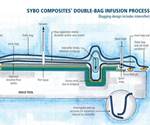Double-bag infusion: Thickness gradient and pressure
Cliff Walker (Vacmobiles, Auckland, New Zealand), explains how the large pressure changes during infusion result in laminate compression and thickness variations across the part.
Share
Read Next
Cliff Walker (Vacmobiles, Auckland, New Zealand), explains how the large pressure changes which occur during infusion do result in laminate compression and thickness variations across the part: “Prior to resin flow, the absolute pressure inside the bag tends to be uniformly low (vacuum uniformly high). When resin starts to flow, the absolute pressure inside the bag at the resin feed rises toward atmospheric pressure (vacuum decrease toward zero), while the pressure remote from the resin feed (closest to the vacuum pump) remains low.” He goes on to say that without a double bag setup, the bag close to the resin feed will loosen and the laminate will increase in thickness, while the part of the bag near the vacuum pump will remain taut, compressing the laminate.
The Boeing Co.’s (Seattle, Wash.) patent for its Controlled Atmospheric Pressure Resin Infusion CAPRI double-bagging method notes, “Achieving a high fiber volume fraction requires compaction of the preform. Proper constraint of the preform against the forming surface during and after the infusion until the resin cures is critical.” It goes on to say: “If the net compaction pressure is insufficient (in traditional VARTM, it can approach zero) the preform is free to float in the resin or to spring back from its compacted state, leading to reduced fiber volume fractions.”
Walker counsels that bag loosening or swelling at the resin feed can be overcome without a double bag by reapplying vacuum to the resin feed region after the part has been filled with resin and resin supply has been stopped. Vacmobiles achieves this by adding another vacuum line to the same vacuum pump. However, the company reportedly has a new machine equipped with two vacuum pumps and two resin traps that can be run independently of each other.
Related Content
-
A new era for ceramic matrix composites
CMC is expanding, with new fiber production in Europe, faster processes and higher temperature materials enabling applications for industry, hypersonics and New Space.
-
Cryo-compressed hydrogen, the best solution for storage and refueling stations?
Cryomotive’s CRYOGAS solution claims the highest storage density, lowest refueling cost and widest operating range without H2 losses while using one-fifth the carbon fiber required in compressed gas tanks.
-
ASCEND program update: Designing next-gen, high-rate auto and aerospace composites
GKN Aerospace, McLaren Automotive and U.K.-based partners share goals and progress aiming at high-rate, Industry 4.0-enabled, sustainable materials and processes.





.jpg;maxWidth=300;quality=90)




